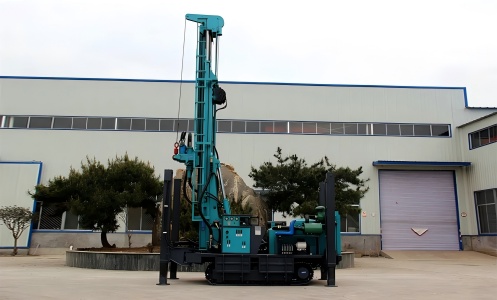Your Position: ![]() Home > News > Industry News
Home > News > Industry News

The collaborative process of an air compressor drill rig (usually referring to a pneumatic drill rig, such as a
down-the-hole drill or rock drill) is a complete system that converts electrical or diesel energy into compressed
air power for rock drilling. Its core principle is the use of high-pressure air as both a power source and a slag removal medium.
The following is a detailed workflow, divided into five main stages. This article will discuss the first two stages:
Main Components of the System
Before understanding the process, let's first identify several key pieces of equipment:
Air compressor: Provides the power source for high-pressure air.
Drilling rig: Includes the propulsion mechanism, rotation mechanism, and pneumatic impactor (or rock drill).
Drill rod and drill bit: The drill rod transmits impact and rotation, while the drill bit directly breaks the rock.
Dust removal system: Typically a dust collector or water sprayer.
Detailed Workflow
Stage 1: Preparation
Equipment Positioning and Inspection: Move the drilling rig to the designated drilling location and secure it securely.
Check that the connecting pipes to the air compressor and drilling rig are secure and that the oil and water levels are normal.
Connecting Pipes: Securely connect the air compressor's outlet to the drill rig's air inlet using a high-pressure hose.
Starting the Air Compressor:
Electric Air Compressor: Connect the power cord and start the air compressor.
Diesel Air Compressor: Start the diesel engine.
The air compressor begins operating, compressing the incoming atmospheric air through multiple stages to the required
high pressure (typically 1.0-2.5 MPa) and storing it in the air tank. At this point, the compressed air line is filled with
high-pressure air, but the valve to the drill rig is closed.
Phase 2: Hole Opening and Drilling (Core Working Cycle)
This is a continuous cycle, the principle of which is illustrated in the following diagram:
Power Transmission and Rock Fracturing: As shown in the diagram above, the operator opens the drill rig's control valve,
and high-pressure air enters the drill rig, simultaneously generating three effects: impact, rotation, and slag removal.
Slag removal (blowing the bottom of the hole): Rock dust generated by impact and rotation must be promptly removed,
otherwise it will be repeatedly ground, significantly reducing drilling efficiency. As shown in the figure above, after completing
its power mission, most of the high-pressure air will blow to the bottom of the hole along the channel inside the drill pipe,
forming a high-speed airflow, which will forcefully blow the rock powder out of the hole through the annular space between
the drill pipe and the hole wall.
#aircompressor #drillingmachine #drillingrig #deepthehole #dth #hammer #hammerbits #drillbits #rockbits
![]() +86 13140012636
+86 13140012636